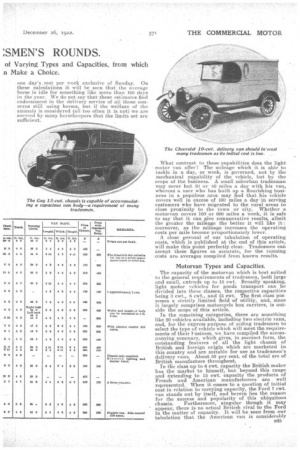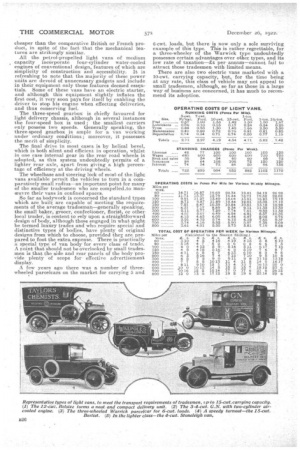VANS FOR THE '
Page 16

Page 17

Page 18

If you've noticed an error in this article please click here to report it so we can fix it.
,SMEN'S ROUNDS.
Outstanding Features of Twenty Light Deliver) the Progressive Tra of Varying Types and Capacities, from which n Make a Choice.
NOT so many years-ago, the question of horse versus motor formed a bone of contention between the exponents of the relative forms of transport. With the weight of opinion only slowly turning in favour of the mechanically propelled vehicle, tradesmen generally were not, at that time, too eager to adopt a method of transport which had yet to prove its worth. Obviously, certain traders had to do the spadework, and that they pioneered a movement which has since proved its commercial value to the country, is a testimony to their visionary powers. It is, in fact, largely due to the early experiments of some of the big wholesale and retail trading concerns that the light van owes its present popularity, an indication of the strength of which is reflected in the continually increasing numbers of light vans to be seen on the road.
With the march of time and the dawn of the mechanical age, the controversy of yesterday has to-day assumed an entirely different aspect. Nowadays, the tradesman is a complete convert to mechanical power, and his chief concern is to obtain a type of motor vehicle which will best suit his particular needs, and enable his delivery system to be run on efficient and economical lines.
The lightmotor vehicle can give excellent results in the service of small tradesmen with one or two shops proportionate to those secured by large concerns with, perhaps, a number of branch establishment. Those traders who are in a, small way of business, and who think,that the light van is beyond their means, will eventually find that customers express a decided preference for more up-to-date delivery than the horse vehicle can possibly give. Failing their realization of this important fact, they may only be brought to acknowledge lack of enterprise after they have found that astute and progressive competitors have attracted some of their trade, as a direct result of ability to give speedier and more reliable,serviee.
The Working Limits of the Van Horse and Motor.
It is acknowledged that the horse is still a factor to be reckoned with in certain trades, but this is not so much due to its suitability for the job as to the inability of those concerned to appreciate the many advantages which the modern motor van offers.
It is unnecessary to reiterate the fundamental weaknesses of the horse, and the horsed vehicle for they have been expounded time and again, and the poor animal has not a leg to stand upon when compared with the average modern livid van, which has given ample proof of its efficiency and reliability under varying conditions of working.
B24
It. might not be out of place, in passing, perhaps, to give some idea of the working limits of the van horse. Generally speaking, a, single-horsed van cannot be worked economically over a greater distance than 25 miles per day ; with a pair-horse van the distance is up to 10 miles more. The average working hours that a seasoned horse can operate are from 45-50 per week, and the average animal requires
one day's rest per week exclusive of Sunday. On these calculations it will be seen that the average horse is idle for something like more than 100 days in the year. We do riot say that these estimates find endorsement in the tieliVery service of all those concerns still using horses, but if the welfare of the animals is considered (all too often it is not) we are assured by many horsekeepers that the limits set are sufficient.
What contrast to these capabilities does the light motor van offer? The mileage which it is able to tackle in a day, or week, is governed, not by the mechanical capability of the vehicle, but by the scope of the business. A small suburban tradesman may cover but 30 or 40 miles a day with his van, whereas a user who has built up a flourishing business in a populous :areamay find that his vehicle covers well in excess of 100 miles a day in serving customers who have migrated to the rural areas in close proximity to the town or city. Whether a motorvan 'covers 100 or 600 miles a week, it is safe to say that it can give remunerative results, albeit the greater the mileage the better it will like it.: moreover, as the mileage increases the operating costs per mile become proportionately lower.
A close perusal of GUY tabulation of operating costs, which is published at the end of this article, will make this point perfectly. clear. Tradesmen can accept these figures as accurate, for the running costs are averages compiled from known results.
Motorvan Types and Capacities.
The capacity of -the motorvan which is hest suited to the general requirements of tradesmen, both large and small, extends up to 15 cwt. Broadly 'speaking, light motor vehicles for goods transport can be divided into three classes, the respective capacities being 3 cwt., 8 cwt., and 15 cwt. The first class possesses a strictly limited field of utility, and, since it largely comprises motorcycle box carriers, is outside the scope of this article.
Tn the remaining categories, there are something like 20 vehicles available, including two electric vans, and, for the express purpose of aiding tradesmen to select the type of vehicle which will meet the requirements of their business, we have compiled the accompanying summary, which gives, in succinct form, the outstanding features of all the light chassis of British and foreign origin which are marketed in this country and are suitable for use as tradesmen's delivery vans. About 50 per cent. of the total are of British manufacture throughout. In the class up to 6 ewt. capacity the British maker has the market to himself, butbeyond this range and extending to 15 cwt. capacity the products of French and American manufacturers are well represented. When it comes to a question of initial cost in relation to-carrying capacity, the Ford 7 cwt. van stands out by itself, and herein lies the reason for the success and popularity of this ubiquitous
chassis. Furthermore, singular though it may appear, there is no actual British rival to the Ford in the matter of capacity. It will be seen from out tabulation that the American van is considerably
cheaper than the comparative British or French product-, in spite of the fact that the mechanical features are strikingly similar.
All the petrol-propelled light vans of medium incorporate ncorporate four-cylinder water-cooled engines of conventional design, features of which are simplicity of construction and accessibility. It is refreshing to note that the majority of these power units are devoid of unnecessary gadgets and include in their equipment only those features deemed essentials. Some of these vans have an electric starter, and although this equipment slightly inflates the first cost, it very soon pays for itself by enabling the driver to stop his engine when effecting deliveries, and thus conserving fuel.
The three-speed gearbox is chiefly favoured for light delivery chassis, although in several instances the four-speed box is used ; the smallest carriers only possess two speeds. Generally speaking, the three-speed gearbox is ample for a van working under ordinary conditions; moreover, it possesses the merit of simplicity.
The final drive in most cases is by helical bevel, which is both silent and efficient in operation, whilst in one case internal gear in the rear road wheels is adopted, as this system undoubtedly permits of a lighter rear axle, apart from giving a high percentage of efficiency at the driving wheels.
The wheelbase and steering lock of most of the light vans available permit the vehicles to turn in a comparatively small radius-an important point for many of the smaller tradesmen who are compelled.to manoeuvre their vans in confined spaces.
So far as bodywork is concerned the standard types which are built are capable of meeting the requirements of the average tradesman-generally speaking, the small baker, grocer,. confectioner, florist, or other local trader, is content to rely upon a straightforward design of body, although those engaged in what might be termed luxury trades and who require special and distinctive types of bodies, have plenty of original designs from which to choose, provided they are, prepared to foot the extra expense. There is practically a special type' of van body for every class of trade. A point that should not be overlooked by small tradesmen is that the side and rear panels of the body provide plenty of scope for effective advertisement display.
A few years ago there was a number of threewheeled parcelcars on the market for carrying 5 and 6-cwt. loads, but there is now only a sole surviving example of this type. This is rather regrettable, for a three-wheeler of the Warwick type undoubtedly possesses certain advantages over other, types, and its low rate of taxation-.E4 per annum-cannot fail to attract those tradesmen with limited means.
There are also two electric vans marketed with a IThewt. carrying capacity, but, for the time being at any rate, this class of vehicle may not appeal to small tradesmen, although, so far as those in a large way of business are concerned, it has much to recommend its adoption.






























